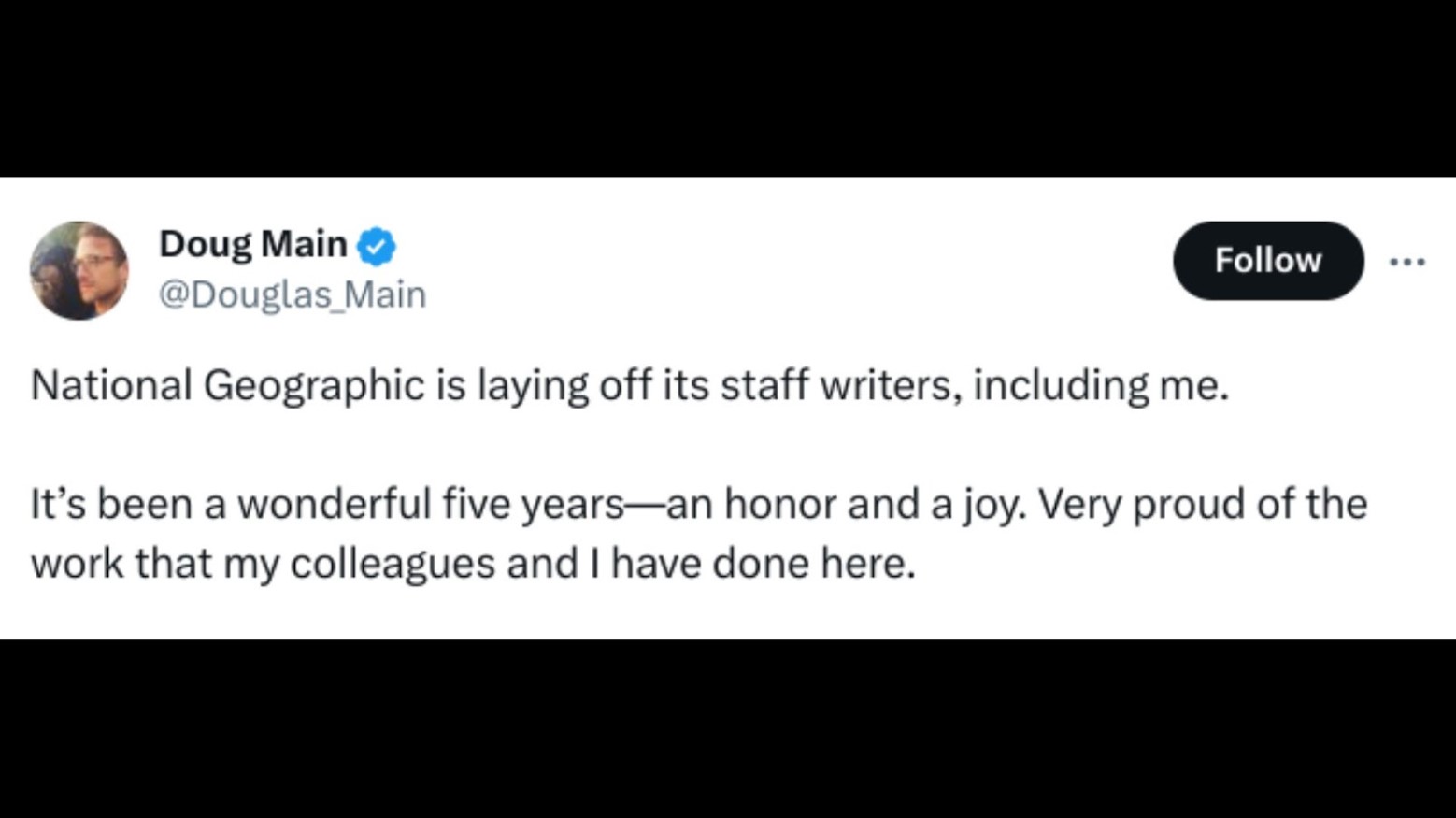For 136 years, National Geographic has been one of the leading publications for scholarly information about the physical and human geography of planet Earth.
And while National Geographic certainly isn’t closing its doors, it has made some serious changes this year, including an announcement that it would be laying off all remaining staff writers.
The National Geographic Announcement

National Geographic’s proclamation explained that the company would no longer employ any staff writers, 17 editorial positions would be eliminated, and the entire podcast team would be removed.
Some of these employees have worked for Nat Geo for more than four decades, and all in all, thousands of people are losing their jobs.
What Does This Have to Do with Disney?

It’s important to note that the announcement came only a couple of years after giant entertainment brand Disney purchased the famous publication.
And it seems that this shocking change is directly tied to Disney’s decision to cut down on expenses across its many businesses and platforms.
The Media Industry Is Struggling

Of course, it’s not just Disney that’s in a bit of trouble. Almost every media and entertainment company is feeling the effects of the SAG-AFTRA strikes and the vast changes within the industry.
In fact, companies such as Vice Media, Buzzfeed, and even CNN have all had to make huge cuts within the past year in order to stay afloat.
CNN Cuts

CNN’s most recent large-scale cuts to staff happened at the end of 2022. At that time, CNN laid off hundreds of staff members, according to CNBC. These cuts were in response to an effort by company owners Warner Bros. Discovery to lower costs as CEO Chris Licht wants to grow the company’s audience.
In a memo to staff, Licht wrote “At the highest level, the goal is to direct our resources to best serve and grow audiences for our core news programming and products.”
Brutal Start to 2024 for News Industry

In a January 25th article, CNN reported on the trend of newsrooms across the country to lay off their staff. All of these cuts happened in a relatively short period of time, causing massive unrest in the industry because it happened all at once.
The previous year was reportedly the worst for job cuts in journalism since 2020, with this year shaping up to give 2023 a run for its money.
The Washington Post Also Eliminated Jobs

The end of 2023 was difficult for the Washington Post. In October the news organization announced they were going to eliminate 240 jobs, according to the New York Times.
The plan was to offer voluntary buyouts in an effort to cover costs for the Post. However, the company got more than it bargained for when a protest consisting of over 750 journalists and staffers walked off the job in protest for a day.
The Situation at Sports Illustrated

Another chaotic chapter of the media landscape’s layoffs happened at Sports Illustrated. According to the New York Times, the Sports Illustrated Union objected to a recent round of layoffs to such a degree that it prompted them to pursue a legal lawsuit.
Their suit alleges the company was engaged in union-busting practices. The layoffs came from Sports Illustrated publisher Authentic, who terminated an agreement that resulted in the entire staff being laid off.
National Public Radio’s Struggles

Despite National Public Radio (NPR) being funded directly by the government, it also relies on donations from its viewers to fund some of its programming and affiliate stations.
In 2023 NPR canceled four of its popular programming podcasts and laid off around 10% of its workforce. Reportedly, the nonprofit news organization experienced a budget shortfall of around $30 million.
The Los Angeles Times Endured a Walk-off Protest

In one of the largest layoff rounds so far, the Los Angeles Times announced in January that it would be letting go of over 20% of its newsroom, according to Fox Business.
The L.A. Times was forced to deeply cut its staff because of financial losses being suffered. Just days before the cuts, the LA Times Guild organized a walk-off protest at the newspaper organization.
Time Magazine Layoffs

The red border of a magazine from Time Magazine is almost as iconic as the golden Nat Geo border. Time also announced a recent layoff in January of their editorial staff.
CNN reported that the iconic publication decided to lay off 15% of its unionized staff. The number of employees who were laid off from the incident totaled around 30, many of them being journalists.
Cuts at Vice

Some of the more brutal cuts in the industry happened at Vice Media Group. In 2023 it made a series of layoff rounds, putting in an effort to restructure the company as it underwent bankruptcy.
The results of the restructuring were that several news shows were canceled, and around 100 staff members were let go in the final round of layoffs, according to CNN.
Buzzfeed Staff Layoffs

In 2023, Variety Magazine reported that Buzzfeed was shutting down its Buzzfeed News division and laying off around 15% of its total workforce. This equates to around 180 total workers in Buzzfeed News and other areas of the organization.
CEO Jonah Peretti wrote in a memo to staff “While layoffs are occurring across nearly every division, we’ve determined that the company can no longer continue to fund BuzzFeed News as a standalone organization.”
Business Insider is Cutting Staff

According to CNN, Business Insider announced a total 8% cut to its staff. It relayed these cuts to staff through an office memo. Business Insider’s chief executive Barbara Peng wrote in the memo that the news outlet needs to change its focus and make “efforts toward this future.”
“Unfortunately, this also means we need to scale back in some areas of our organization,” Peng wrote.
What Is Causing So Many Layoffs From Popular Media Organizations?

There are a variety of possible causes for media companies to be laying off employees around the same time. The increasing reliability in AI has disrupted the news media environment, with the industry undergoing a major transformation. People just aren’t reading news and finding information the same way they used to.
Also, the recent economic downturn and declining revenue has made business leaders in these organizations rethink staffing levels in this environment.
Impact of Unions on the Industry

In an effort to protect their salary, media staff members are increasingly relying on unions to fight back against corporate cuts. The Pew Research Center found in 2022 that 26% of U.S journalists employed by a news organization are part of a union.
However, unions can only do so much to protect employee salaries when the industry is going through an upheaval. No amount of collective bargaining can ultimately fix declining business revenue, these media businesses need to be able to fund their operations first.
What Do the Nat Geo Changes Mean for the Publication?

First and foremost, it’s important to understand that the decision to lay off staff writers does not mean that National Geographic is shutting down in any way.
Instead, they simply plan to utilize freelance writers and editors. Freelance jobs will be available on a project-to-project basis, meaning that some will simply be employed to write one-off articles, whereas others may stay on board for several weeks or even months.
Freelancers Will Save Nat Geo a Significant Amount of Money

If Nat Geo will still be employing writers and editors, why change from staff employees to freelancers?
Essentially, staff employees are just far more expensive than freelancers. From annual salaries to benefits and healthcare, permanent employees can cost a fortune. But freelancers are only paid per project and don’t receive any bonuses, benefits such as 401ks, or insurance.
How Do National Geographic Writers Feel about the Change

Unsurprisingly, most of the staff writers and editors at Nat Geo are disappointed with the company’s decision. Some of them will continue working as freelancers, but that means less money and no real job security.
Several members of staff took to X, formerly Twitter, to post about the changes. Most wrote about their fantastic experience working for Nat Geo, as well as their dissatisfaction with the decision. @Douglas_Main/X wrote, “National Geographic is laying off its staff writers, including me. It’s been a wonderful five years—an honor and a joy. Very proud of the work that my colleagues and I have done here.”
Nat Geo Claims the Changes Won’t Affect the Quality of the Publication

A National Geographic spokesperson made a statement about the decision to lay off all staff employees, claiming that it will not affect the long-standing quality of their articles.
They said, “Staffing changes will not change our ability to do this work, but rather give us more flexibility to tell different stories and meet our audiences where they are across our many platforms.”
Say Goodbye to the Beloved Yellow-Bordered Magazine

Additionally, National Geographic announced at the same time that they would no longer be selling their magazines on newsstands in the United States.
Instead, they will be focusing on digital media entertainment, such as their website and social media accounts. And while many are extremely disappointed in this reality, the truth is that print is simply going out of style.
Increasing Subscriptions

In the 1980s, National Geographic boasted some 12 million subscribers. However, as of 2022, they only had 1.8 million.
But the publication hopes that its adjustment from staff writers and printed magazines to freelancers and online content will not only cut costs and allow them to continue their important work but also improve subscriptions and customer engagement.
Digital Subscription Means More Information

In order to make that dream a reality, National Geographic is offering quite a comprehensive premium subscription package on its website.
Instead of simply receiving a magazine in the mail, Nat Geo subscribers will now get exclusive daily content, unlimited access to the digital archive, downloadable stories on their ad-free app, and even a weekly newsletter for $19 a year.
National Geographic Will Hopefully Be Around for Another 136 Years

While these changes will certainly affect the employees of the magazine and the few people who still purchased the printed copies from the newsstand, overall, it seems like the right call for Nat Geo.
And hopefully, by cutting down on costs and focusing its energy on digital media, National Geographic will be around for another 136 years, telling the world everything they need to know about the planet we live on.
